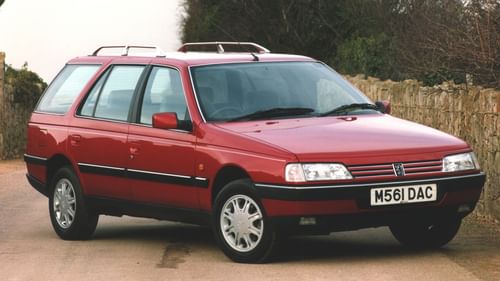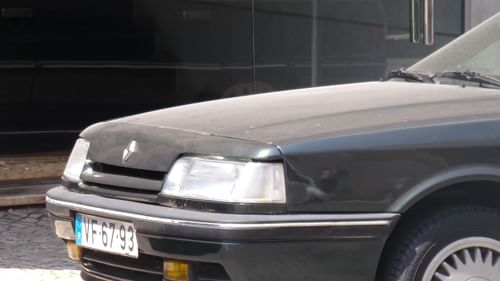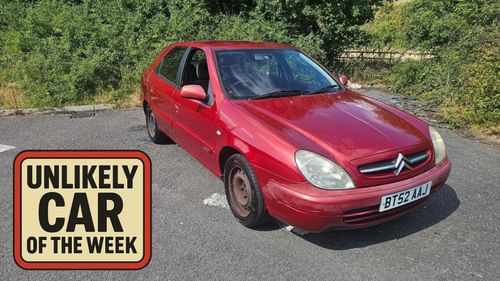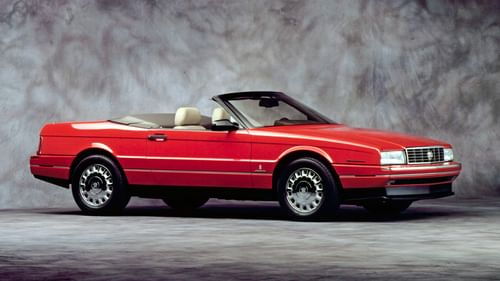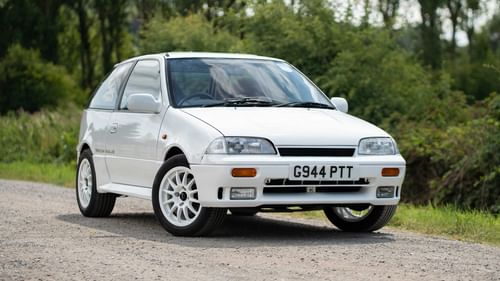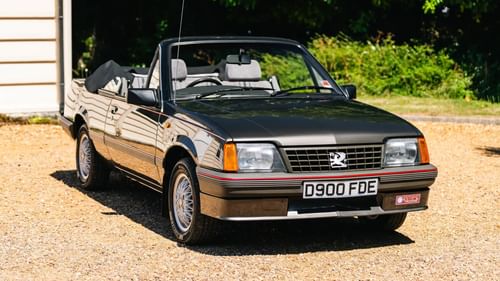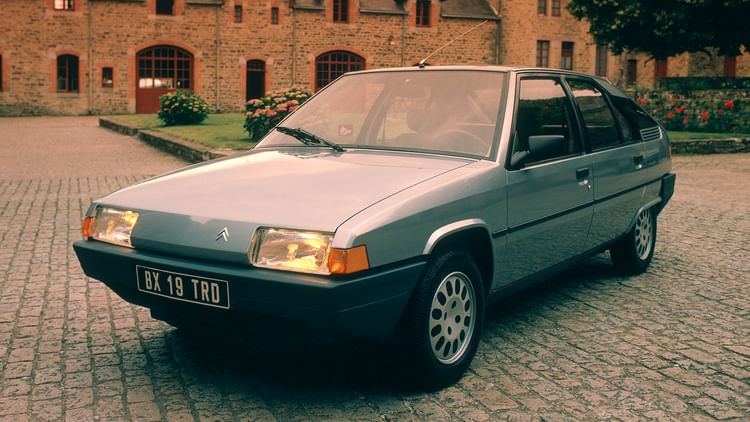
It took a week for the wooden crate to hit the ground. Suspended from a rarely photographed tower in the centre of Paris – google ‘Eiffel Tower’ if you’re not familiar with it – the box, marked ‘La Nouvelle Citroën’, descended a few metres every day until it reached terra firma.
Then, on 23 September 1982, members of the press gathered as Jacques Lombard, general manager of Citroën, opened the box to reveal a red BX. And you thought unboxing was a product of the YouTube era. Yet another example of Citroën’s pioneering spirit.
This wasn’t the first time Citroën had commandeered the Eiffel Tower as a promotional tool. In 1925, André Citroën rented the tower to use as a gigantic billboard, illuminating the structure with 250,000 bulbs, which remained a fixture of the Paris skyline until 1934. The pre-launch activity for the BX was less incandescent, but the marketing team would have welcomed the lower electricity bill, if not the health and safety paperwork associated with suspending a car from one of the world’s most-visited tourist attractions.
As the second new Citroën to be developed following the takeover by Peugeot in 1976, there were concerns that the BX would be devoid of the company’s famed eccentricity and individuality. Indeed, writing in CAR (October 1998), a sceptical Steve Cropley raised the question of whether it was a real Citroën, expressing concerns over a ‘hurriedly-built Meccano-car’ which ‘might be mistaken for a particularly nice Talbot’. He conceded that the BX was ‘more desirable’ than the Renault 9 – the then current European Car of the Year (ECoTY) – before concluding that ‘history will decide’ its fate. More than four decades on, and with 2.3 million sales under its composite belt, history will recall a success story for the company and, most importantly, a real Citroën, albeit one with mixed parentage.
Claims that the Citroën BX was little more than a repurposed Volvo Tundra are a little wide of the mark. Although Marcello Gandini’s stunning concept of 1979 was undoubtedly the biggest influence, Citroën began work on Project XB much earlier. Visit the excellent Citroënët website and you’ll discover images of wooden models built by Jean Giret and based on Robert Opron designs of the 1960s. Later designs show a general direction for the BX, including plaster models with far too much influence from Peugeot, but Citroën was quick to capitalise on Volvo’s decision to reject Gandini’s proposal for the Tundra. Too radical for the Swedish company, but perfect for a French firm in desperate need of a car to fill the gap between the GSA and CX. Gandini also borrowed elements from his work on the FW11 for Reliant and Anadol, along with details from the Fiat X1/10 concept of 1979. Some even argue that the Citroën BX is a distant relative of the Triumph SD2 concept of 1974. Whatever the lineage, the BX ranks as one of Gandini’s finest designs. Good enough to decline the opportunity to drive a Lamborghini Countach to the office…

Citroën couldn’t have picked a worse time to launch the BX. The simultaneous arrival of the Audi 100 and Ford Sierra – first and second in the 1983 ECoTY – overshadowed the debut of a car that would see Citroën through the 1980s and beyond. For a company accustomed to taking top billing with its major launches, seeing its mid-size newcomer relegated behind the aerodynamic Audi and far-out Ford must have stung a little. Or maybe not. A large serving of mainstream normality with a dash of individuality was precisely what Citroën needed to succeed.
Beneath the origami styling – which looked a little out of place in a new era of slippery shapes – the BX sat on an all-new platform that would be shared with the forthcoming Peugeot 405. Similar in size to the GSA, the BX was significantly larger inside, making it considerably more spacious than the Ford Escort and Vauxhall Astra. Large enough, in fact, to rival cars from a class above, albeit without the size of engines required to make it a genuine threat to the Sierra, Cavalier and the like. Not at launch, anyway.
Speaking of the Sierra, Ford was justifiably proud of its new car’s drag coefficient of 0.34, which shaved 0.11 Cd off the Cortina’s figure. Meanwhile, the Audi 100’s revolutionary flush-fitted side windows helped it to achieve a figure of 0.30. Citroën was less willing to shout about the BX’s Cd of 0.34, probably because the GS achieved a figure of 0.31… in 1970. This led to a rather passive-aggressive statement in the first UK brochure: ‘These days you’ll hear about aerodynamics from people who only began to take the subject seriously as fuel prices rose in the mid-seventies. However, the story is not as simple as they sometimes make it sound. The BX’s 0.34 may seem marginally less good than figures claimed for a recently introduced model from another manufacturer. But when profile and surface measurements are combined to take more meaningful account of the fact that any car is actually a three dimensional object, a different picture emerges.’ Siri, show me an example of subtweeting before Twitter was a thing.
In fairness, the BX didn’t require headline-grabbing aerodynamics to achieve excellent fuel economy. Depending on the model, the BX weighed as little as 870kg, thanks to the pioneering and widespread use of composite materials for non-structural panels. A pressed composite polyester-glassfibre bonnet (5kg lighter) on all except the base models, an injected composite polyester-glassfibre tailgate (1.3kg lighter) and a reinforced polyamide fuel filler flap/cap were the most visible and tactile developments. A rear window bonded to the tailgate was a first for a mass-production car, saving another 2.5kg in weight. The polycarbonate rear quarter window of the flagship TRS was 50 percent lighter than glass, while the use of polypropylene EDPM bumpers were impact resistant up to 5km/h and removed the need for separate energy absorbers. Even the use of headlights featuring homofocal parabolic reflectors in injected polyester-glassfibre was a first for the industry. Stuff that’s difficult to portray as sexy in a brochure but help to deliver better fuel efficiency for the motorist. The BX also delivered several firsts for the company, but there was precious little to fend off complaints from Citroënistes that it wasn’t a real Citroën.

Even the hydropneumatic suspension caused a stir, with the traditional double wishbones at the front replaced by MacPherson struts. This combination was another first for the company. The rear suspension featured semi-trailing arms lying flat to limit intrusion into the boot. Anti-roll bars front and rear was another break from tradition, but a hydropneumatic-powered all-round disc braking system wasn’t.
Just two engines were available at launch: a Douvrin 1360cc engine developing 62bhp or 72bhp depending on the model, and an all-new 90bhp 1580cc XU unit. A 0-62mph time of 15.6 seconds for the lowliest engine feels comically slow by today’s standards, but the BX was surprisingly fleet of foot, be it wrestling with town centre congestion or cruising on a motorway. The 72bhp version shaved a couple of seconds off the sprint time, while the larger engine could propel the BX to 62mph in 11.3 seconds. Fuel economy ranged from 31.4mpg to 36.7mpg, depending on the engine and output. Respectable figures at a time when anything from 25mpg to 35mpg was the norm for a car of this size. Evaluating the 72bhp version of the 1360cc engine, Autocar advised readers to choose the 1580cc engine, describing the performance as ‘well up to expectations – which are inevitably fairly low’. The road test went on to say the BX was slower through the gears than a 1116cc Fiat Uno, but did concede that the BX sounded and felt ‘much quicker on the road than the unspectacular times might imply’. Two months later, Autocar said the 1580cc version ‘goes much better and is fully competitive with the other cars which might logically be considered to be its opposition’.
The concluding paragraph from the Autocar road test is rather telling. It said: ‘The BX16 is, then, a true Citroën, excelling at what the French marque have always been noted for – economical, comfortable long distance cruising.’ Fears about the BX not being a real Citroën put to bed.
Strong demand for left-hand drive models meant that Britain would have to wait until September 1983 for the first BXs to arrive. It launched with five models: the base BX with a four-speed gearbox and 62bhp; the BX14 E, the same spec but five-speed gearbox and 72bhp; BX14 RE, as per E but with more kit; BX16 RS, similar spec to RE, but with 1580cc engine; BX16 TRS, the luxury and performance flagship. None could be described as basic, with even the entry-level version boasting a single key for the ignition, doors, tailgate and filler flap, two-speed plus intermittent wiper, front head restraints and a proper Citroën dashboard. In other words, a rotating drum speedo and a single-spoke steering wheel flanked by satellite controls for the lights and wipers. Citroën also claimed the BX had ‘one of the best heating and ventilation systems ever’, with six dashboard vents and provision for rear passengers. Steve Cropley agreed, describing the ventilation as ‘excellent’ and saying Citroën had ‘really excelled themselves’.

The BX could have become just another Citroën: critically acclaimed, loved by purists, but largely ignored by the wider public. Everything changed with the arrival of the 1905cc XUD diesel engine in 1984, not just for the BX, but for Citroën as a company. Diesel sales in the UK were on the up, increasing from 2600 in 1977 to around 25,000 in 1983. Manufacturers and oil companies were predicting a 10 percent market share by the end of the decade, which just goes to show how much has changed in forty years; diesel accounted for just 8.2 percent of UK new car registrations in 2021.
Testing the BX19 RD alongside diesel versions of the Volkswagen Golf and Ford Orion, CAR said: ‘There’s no doubt that the extra Citroën performance makes it easily the most attractive from the driver’s point of view – it goes like a petrol car, rides the best and handles with precision. It has the best driving position, the most cabin room and it gives you an immediate feeling of confidence.’ The BX achieved an official 43.5mpg in the city and 60.1mpg at a constant 56mph; little wonder it became the darling of the company car sector, catapulting Citroën into the top ten sales charts and the BX as a regular best-selling diesel car. Uncharted waters for Citroën in the UK. Major service intervals of 15,000 miles, 2.7 hours of servicing every year and a savings of 2p per mile for the BX diesel were the kind of figures that looked incredibly attractive to a calculator-wielding fleet manager. Saving money was one thing, but saving the planet was a different story. Citroën’s claim that driving a diesel meant that drivers were ‘looking after the planet’ seems horribly outdated and misguided in 2022.
There was nothing misguided about Citroën’s decision to add a turbocharged version of the XUD engine to the range. With 90bhp at its disposal, the DTR Turbo was the closest the BX diesel came to delivering the performance and refinement of a petrol version, yet with the promise of 50mpg. The UK-only BX TZD Turbo, which utilised the 1769cc version of the XUD, was like a BX GTi with a diesel engine. An example of the BX adapting to its surroundings and market conditions; a mid-size car conceived with petrol engines, but with its success underpinned by diesel power.
The Heuliez-built estate version arrived in 1985. Almost seven inches longer than the saloon, the wagon was the perfect, ahem, BXtension of the range. Its hydropneumatic self-levelling suspension, power and torque characteristics, particularly in diesel form, and usefully large rear opening made it ideal for load-lugging purposes. In a 1986 Motor group test, the BX narrowly beat the estate versions of the Austin Montego, Ford Sierra, Peugeot 305, Vauxhall Cavalier and Volkswagen Passat. The boot could swallow eleven tins of paint, five boxes of pipe insulation, four bathroom cabinets, four ventilation systems and a partridge in a pear tree.

For a car built on the promise of cheap motoring – remember the ‘Loves driving… hates garage’ launch campaign? – the arrival of the performance variants was less predictable than the estate. First, in the form of the 105bhp 1905cc GT version, and later by the 125bhp GTi, which coincided with the 1986 facelift. The performance flagship could hit 60mph in 8.8 seconds before reaching a top speed of 123mph, but unlike the hard-as-nails hot hatches of the era, the GTi retained the comfort of the BX’s self-levelling suspension, albeit with larger anti-roll bars and different dampers. Other highlights included a tailgate spoiler from the European market BX Sport, special wheel trims (alloys were optional), sport seats and the new dashboard and centre console rolled out as part of the facelift. Less eccentric than before, the revised facia was nevertheless perfect for Citroën’s newfound mainstream acceptance. Also in 1986, Citroën axed the antiquated 1360cc ‘suitcase’ engine and it replaced it with an all-new 1360cc TU unit.
Even better was to come with the 1987 launch of the BX GTi 16v. A new twin-cam head with four valves per cylinder upped the power of the 1905cc engine to 160bhp, enough to complete the zero to 60mph sprint time in 7.9 seconds, making it the fastest Citroën of all. Autocar called the engine (shared with the Peugeot 405 Mi16, ‘an absolute gem’, with one road tester saying the GTi 16v (later renamed BX 16v) ‘is everything a BX should be, and a bit more besides’. A BX GTi 4x4 was added to the range in 1989 but failed to sell in big numbers.
The tragedy of the Citroën BX is that there are few survivors. Even as recently as the turn of the millennium, the BX was a familiar sight in the UK, providing cheap and comfortable motoring to those on a budget. You don’t need to look at the DVLA’s figures to know that the BX is facing a fight for survival. Shunned by some Citroënistes and misunderstood by the masses, it’s now rare to see a BX in the UK. Those that remain tend to be in good shape, but prices are still relatively affordable.
It's a practical classic with a unique blend of Citroën eccentricity and mainstream conformity; a bridge between the old and new. From wooden crate to 2,316,234 sales in twelve years – a towering achievement by any standards. Happy anniversary, Citroën BX.
This article first appeared in issue 14 of Classic.Retro.Modern. magazine.
